What is Cashmere Fabric?
Cashmere fabric is more than just a luxury fabric; it’s a testament to nature’s ability to create something extraordinarily soft and incredibly warm. The magic of cashmere lies in its fibers, which are significantly finer and softer than sheep’s wool, typically measuring between 14 to 19 microns in diameter. These delicate fibers are the reason behind cashmere’s unparalleled softness and insulating capacity. Unlike wool, cashmere offers warmth without the weight, making it a preferred choice for high-quality garments and accessories that offer comfort and elegance in equal measure.
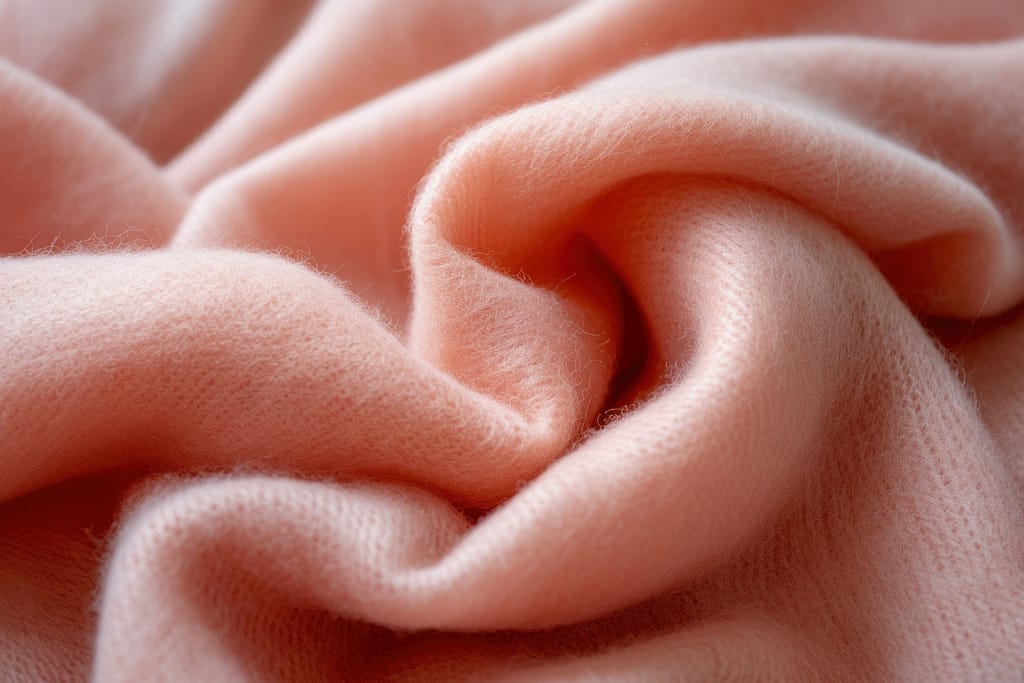
Harvesting cashmere is a meticulous and labor-intensive process that usually takes place in the spring, as goats naturally shed their winter coats. Herders comb the goats to gently remove the undercoat, a method that not only ensures the well-being of the animals but also preserves the integrity of the fibers. This process yields a relatively small amount of cashmere per goat, contributing to the fabric’s exclusivity and high value. After collection, the cashmere fibers undergo sorting, cleaning, and processing to be spun into yarn, woven or knitted into fabric, and ultimately crafted into luxurious garments.
The History of Cashmere
The story of cashmere is as rich and luxurious as the fabric itself. Its roots can be traced back thousands of years to the Kashmir region of the Indian subcontinent, where it was first discovered and utilized by the Kashmiri people. These early adopters of cashmere recognized the material’s exceptional warmth and softness, weaving it into shawls and garments that quickly became coveted items across the Asian continent.
As trade routes expanded, notably the famed Silk Road, cashmere began its journey westward, enchanting royalty and aristocracy in Europe. By the 18th century, cashmere shawls were the height of fashion in France and England, symbols of status and elegance that adorned the shoulders of high society. The demand for these exotic textiles spurred innovations in cashmere fabric production, leading to the establishment of the first mechanical looms in Scotland, a region now renowned for its premium cashmere products.
The industrial revolution of the 19th century further transformed cashmere production, making it more accessible and introducing new techniques for weaving and dyeing the fabric. Despite these advancements, the essence of cashmere remained unchanged, rooted in the skilled hands of artisans who continued to refine the process, ensuring the fabric’s luxurious qualities were preserved.
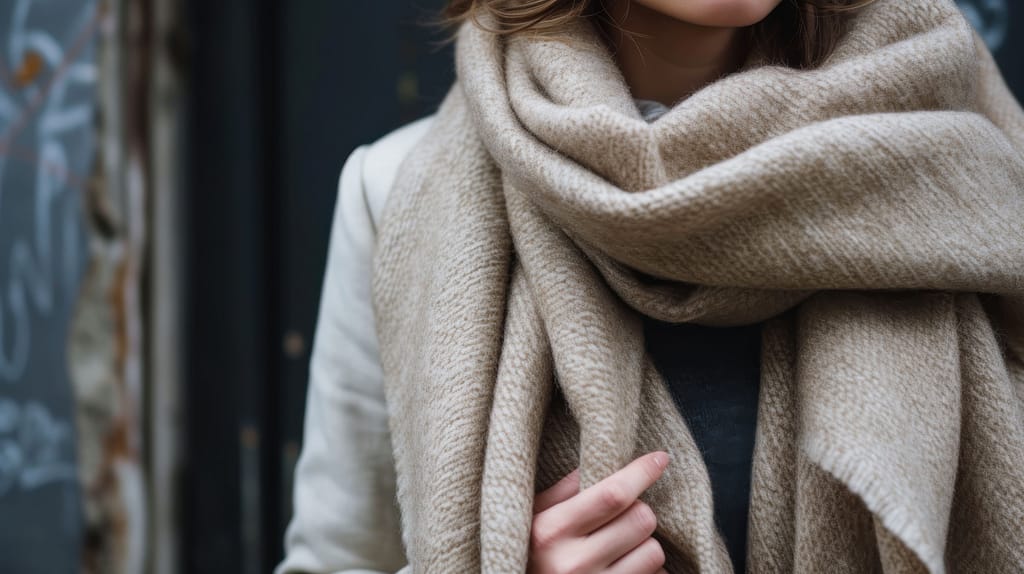
In the 20th and 21st centuries, cashmere fabric has maintained its prestigious reputation, evolving with the fashion industry to become a staple of both luxury and casual wear. Designers and brands around the world incorporate cashmere into their collections, leveraging its unparalleled softness and warmth to create everything from elegant evening wear to cozy sweaters that embody comfort and style.
Characteristics and Benefits of Cashmere Fabric
Cashmere’s esteemed status in the world of textiles is not without good reason. This fabric boasts a range of characteristics and benefits that set it apart from other materials, making it a preferred choice for those seeking luxury, comfort, and durability in their clothing and accessories.
Softness and Warmth Without the Bulk: The most celebrated quality of cashmere is its extraordinary softness, which can be attributed to the fineness of its fibers. Unlike traditional wool, cashmere fibers have a smoother surface, reducing the itchiness associated with woolen garments. Moreover, cashmere fabric provides exceptional warmth without the heaviness or bulk, making it ideal for layering and creating sleek, comfortable outfits suitable for a range of temperatures.
Durability and Longevity: When cared for properly, cashmere garments can last a lifetime, gradually becoming softer with age. The strength of the cashmere fiber contributes to the durability of the fabric, enabling it to withstand wear and tear better than many other materials. This longevity makes cashmere items not only a luxurious choice but also a sustainable one, offering timeless elegance that transcends seasonal trends.
Natural Insulating Properties: Cashmere’s ability to insulate up to three times more effectively than regular sheep’s wool is another reason for its popularity. This natural insulating property means that cashmere garments are equally suitable for cold winter days and cooler spring or autumn evenings, providing warmth without causing overheating.
Hypoallergenic Qualities: For individuals with sensitive skin or allergies to other fabrics, cashmere offers a hypoallergenic alternative. Its natural fibers are less likely to provoke allergic reactions, making cashmere garments a comfortable and safe choice for everyone, including babies and those with delicate skin.
In sum, cashmere’s blend of softness, warmth, durability, and hypoallergenic qualities, combined with its timeless appeal, make it an unparalleled choice in the world of fabrics.
How Cashmere Fabric is Made
The journey from goat to garment is a fascinating process that highlights the craftsmanship and attention to detail involved in producing cashmere. Understanding how cashmere is made not only deepens appreciation for this luxurious fabric but also sheds light on the reasons behind its high value and demand.
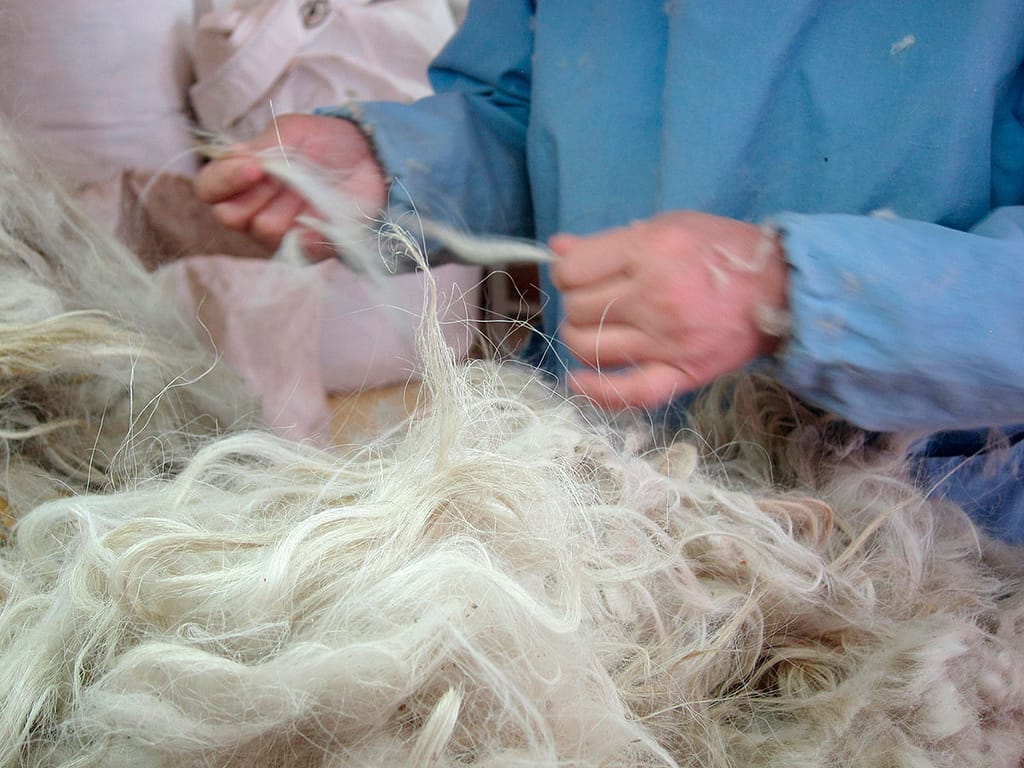
Collection of the Fibers: The first step in creating cashmere involves collecting the fine undercoat fibers from cashmere goats. This typically occurs once a year in the spring when goats naturally shed their winter coats. Herders use a combing method to gently remove the undercoat, ensuring the goats are not harmed. This process is labor-intensive and requires skill to obtain the highest quality fibers without damaging them.
Sorting and Cleaning: Once collected, the raw cashmere fibers are meticulously sorted by hand to separate the fine undercoat from the coarser guard hairs. The fibers are then washed to remove dirt, grease, and impurities. This step is crucial for ensuring the purity and quality of the cashmere before it is processed further.
Dehairing: After sorting and cleaning, the fibers undergo a dehairing process, where the remaining guard hairs are removed, leaving only the softest and finest cashmere fibers. This stage is vital for achieving the signature softness that cashmere is known for.
Spinning: The cleaned and dehaired cashmere fibers are then spun into yarn. The spinning process can vary, with some producers opting for traditional hand-spinning techniques, while others use more modern machinery. The method used can affect the texture and feel of the final product, with hand-spun yarns often having a unique, artisanal quality.
Weaving or Knitting: The spun yarn is then either woven or knitted into fabric or garments. Weaving produces a smoother, denser fabric, ideal for scarves and shawls, whereas knitting results in a more flexible, airy fabric, perfect for sweaters and hats. The choice between weaving and knitting depends on the desired texture and use of the final product.
Finishing: The final step in the cashmere production process is finishing. This may include washing, dyeing, and softening the cashmere fabric, as well as adding any final touches, such as brushing the surface to create a fluffier texture. Quality control is paramount during this stage to ensure the finished product meets the high standards expected of cashmere.
Varieties of Cashmere Fabric
Cashmere’s unique characteristics can vary significantly depending on its source and the methods used in its production. This diversity has given rise to different varieties of cashmere, each with its own set of qualities and appeal. Understanding these variations can help consumers make more informed choices when purchasing cashmere products.
Regional Varieties:
- Mongolian Cashmere: Often regarded as the gold standard, Mongolian cashmere is prized for its softness and durability. Mongolia’s harsh winters result in goats with exceptionally thick undercoats, producing fibers that are both fine and strong. Mongolian cashmere is renowned for its natural luster and ability to retain warmth.
- Chinese Cashmere: China is the largest producer of cashmere, and its version is known for its smoothness and consistency in quality. Chinese cashmere tends to be slightly less expensive than its Mongolian counterpart, making it a popular choice for high-volume production.
- Iranian and Afghan Cashmere: Known locally as “Pashmina,” cashmere from Iran and Afghanistan is highly valued for its ultra-fine fibers and intricate hand-weaving techniques. These regions produce some of the softest cashmere, often used in luxurious shawls and scarves.
Grade Varieties:
Cashmere is also categorized by grades, which are determined by the fineness and length of the fibers:
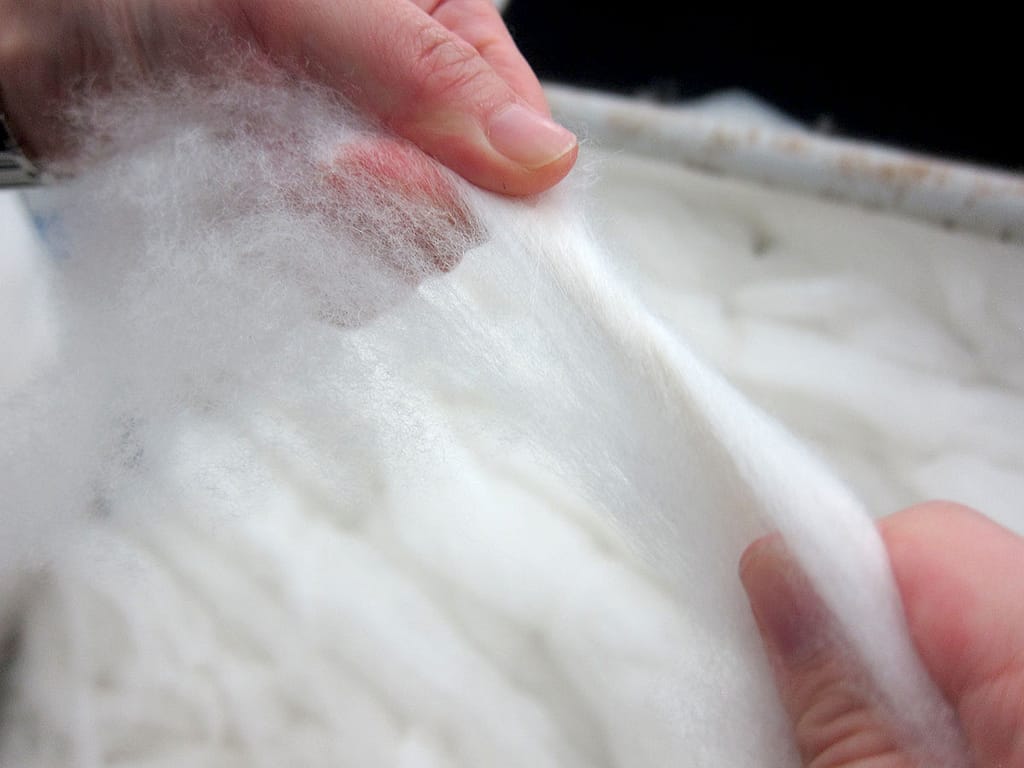
- Grade A Cashmere: The highest quality, with fibers that are at least 14 microns in diameter and 34-36 millimeters in length. Garments made from Grade A cashmere are incredibly soft, lightweight, and durable.
- Grade B Cashmere: Slightly thicker fibers, around 19 microns in diameter, making it less soft than Grade A. However, it still offers significant warmth and comfort.
- Grade C Cashmere: The coarsest quality, with fibers thicker than 30 microns. This grade is less common in apparel due to its reduced softness and is often used in blends.
Blended Fabrics:
In addition to pure cashmere fabric, there are also blended fabrics that combine cashmere fibers with other materials, such as silk, wool, or synthetic fibers. These blends offer different textures and properties, such as increased strength or a different sheen, often at a more accessible price point than pure cashmere. However, blending can also dilute some of the unique qualities of cashmere fabric, such as its softness and warmth.
The variety of cashmere available on the market today means there is something for everyone, from the luxury seeker to the budget-conscious shopper. By understanding the differences in regional sources, grades, and blends, consumers can better navigate the wide array of cashmere products and find the perfect piece that meets their needs and preferences.
Choosing Quality Cashmere
Identifying high-quality cashmere involves understanding the characteristics that contribute to its luxury and longevity. Whether you’re selecting a cozy sweater or a delicate shawl, paying attention to certain details can help ensure that you invest in a piece that combines beauty, comfort, and durability.
Understanding Cashmere Grades: As mentioned earlier, cashmere is graded based on the fineness and length of its fibers. Grade A cashmere, being the finest and softest, is the pinnacle of quality. It’s important to note that while the grade can give you an initial indication of quality, other factors also play a significant role in the overall feel and durability of the cashmere fabric.
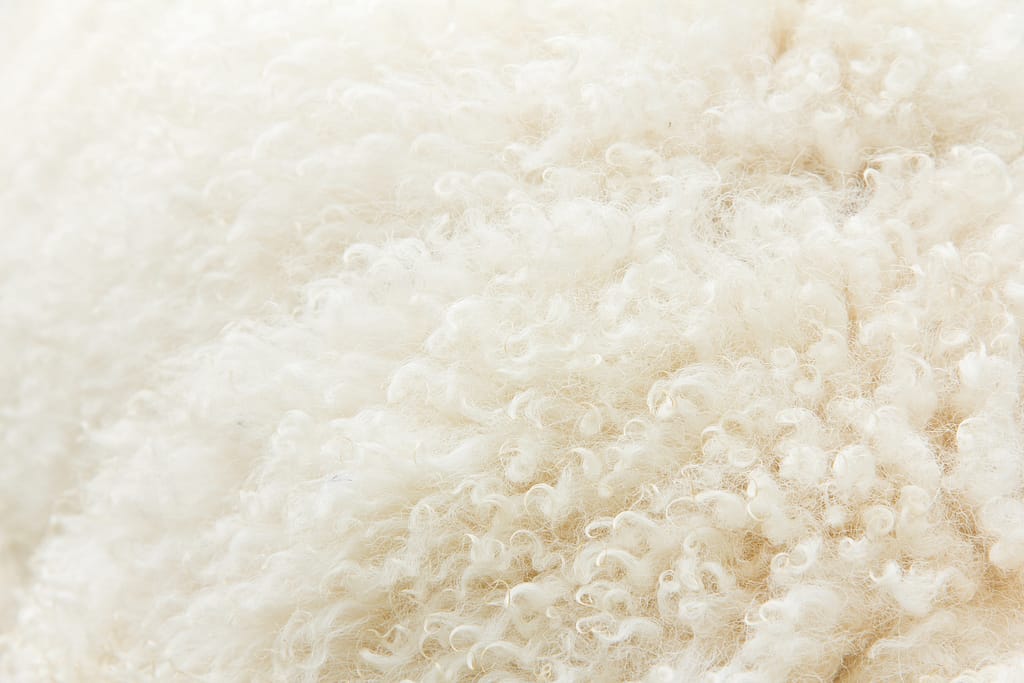
Assessing Weight and Ply:
- Weight: High-quality cashmere products should feel lightweight yet substantial. If a garment feels overly heavy or bulky, it may contain other fibers blended with the cashmere.
- Ply: The ply refers to the number of threads twisted together to make the cashmere yarn. Two-ply or higher cashmere is generally stronger and less prone to pilling than single-ply, contributing to the garment’s overall quality and longevity.
Texture and Softness: The hallmark of quality cashmere is its unparalleled softness. When selecting cashmere fabric, gently rub the fabric against your skin to ensure it feels smooth and soft without any hint of itchiness. Additionally, high-quality cashmere should have a natural, subtle sheen, indicating healthy fibers that have been properly processed.
Resilience and Pilling: Quality cashmere fabric should spring back to its original shape after being stretched, indicating good resilience. Gently stretch a small section of the garment and observe if it returns to form. Pilling is another consideration; while all cashmere may pill to some extent due to friction, higher quality cashmere tends to pill less and can be easily maintained with proper care.
Color and Dyeing: Cashmere fabric that has been dyed should have a rich, even color without any blotchiness or fading. High-quality dyeing processes ensure the fabric retains its color vibrancy over time, enhancing the garment’s aesthetic appeal and longevity.
When shopping for cashmere, it’s also advisable to research the brand or manufacturer to understand their sourcing and production practices. Ethical sourcing and skilled craftsmanship contribute significantly to the quality of the final product. Trustworthy brands often provide detailed information about their cashmere, including the source of the fibers and the manufacturing process, helping consumers make informed decisions.
Caring for Cashmere
Proper care is essential to maintaining the beauty and longevity of cashmere garments. Despite its luxurious quality, cashmere is not difficult to care for if you follow some basic guidelines. Taking the right steps can ensure that your cashmere fabric remains soft, luxurious, and beautiful for years to come.
Washing Cashmere:
- Hand Washing: The recommended method for cleaning cashmere fabric is hand washing. Use lukewarm water and a small amount of gentle, wool-friendly detergent. Submerge the garment and gently agitate the water with your hands, then let it soak for up to 30 minutes. Rinse thoroughly with lukewarm water until the water runs clear.
- Machine Washing: If you must use a washing machine, place your cashmere item in a mesh laundry bag and select the delicate or woolens cycle. Use cold water and a mild detergent. It’s crucial to avoid fabric softeners, as they can damage the fibers.
Drying:
Avoid wringing out cashmere fabric, as it can distort the shape of the garment. Instead, after washing, gently press out the excess water. Lay the item flat on a clean, dry towel, roll up the towel and press to absorb more water, then unroll and repeat with a second dry towel. Lay the garment flat on a fresh towel or a drying rack, reshaping it as needed, and allow it to air dry away from direct heat and sunlight.
Storage:
To prevent stretching or distortion, cashmere fabric should be stored folded rather than hung. For long-term storage, ensure the garment is clean to avoid attracting moths. Store in a breathable cotton bag with cedar blocks or lavender sachets to repel pests. Avoid plastic bags, as they can trap moisture and lead to mildew.
Pilling:
Pilling is natural for cashmere fabric and can be managed with proper care. Use a cashmere comb or a pill remover to gently remove pills. Avoid excessive rubbing or harsh treatments, as these can damage the fabric.
Repairing:
Small holes or tears in cashmere fabric can often be repaired by a professional or with a careful hand-stitching technique. Addressing damage promptly can prevent further unraveling and extend the life of your garment.
By adhering to these care instructions, you can preserve the luxurious feel and appearance of your cashmere garments, ensuring they remain a treasured part of your wardrobe. Proper care not only maintains the quality of cashmere but also supports sustainable fashion practices by prolonging the life of your garments.
Ethical and Sustainable Practices
The increasing demand for cashmere has raised important questions about the ethical and environmental impact of its production. As consumers become more conscious of their purchases, it’s crucial to consider the sustainability of cashmere and the practices involved in its production.
Environmental Impact: The traditional grazing lands of cashmere goats are becoming increasingly strained, leading to overgrazing and desertification in regions like Mongolia and China. Overgrazing can severely damage the ecosystem, leading to soil erosion and a decrease in biodiversity. Sustainable practices, such as regulated grazing and land management, are essential to mitigate these impacts and ensure the long-term viability of cashmere production.
Ethical Considerations: The welfare of cashmere goats is another significant concern. Ethical sourcing ensures that animals are treated humanely, with proper shelter, feeding, and care throughout their lives. It also involves fair treatment and compensation for the herders and farmers who rely on cashmere goats for their livelihoods. Brands and manufacturers committed to ethical practices often participate in certification programs or initiatives that promote animal welfare and support local communities.
Sustainable and Eco-Friendly Cashmere: In response to these challenges, many in the industry are turning to sustainable and eco-friendly cashmere production methods. This includes:
- Recycled Cashmere: Using pre-consumer and post-consumer cashmere waste to create new yarns and fabrics. This approach reduces waste and the demand for virgin cashmere fibers.
- Traceable Cashmere: Implementing traceability systems that allow consumers to know the source of their cashmere, from the goats to the final product. This transparency helps ensure that the cashmere is produced responsibly.
- Organic and Low-Impact Dyeing: Using organic or low-impact dyes reduces the environmental footprint of cashmere products, minimizing water pollution and the use of toxic chemicals.
Conclusion
Cashmere represents the pinnacle of luxury and comfort in the textile world, cherished for its softness, warmth, and elegance. As we’ve explored the journey of cashmere, from its origins to the importance of sustainable and ethical production, it’s clear that the future of this luxurious fabric depends on mindful practices. By choosing ethically sourced cashmere and caring for it responsibly, we contribute to a more sustainable fashion ecosystem, supporting the environment and the communities behind its production.
Embrace the timeless beauty of cashmere with a conscience. Discover our curated collection of high-quality, sustainable cashmere garments, where luxury meets responsibility. Join us in crafting a future where fashion and sustainability are seamlessly intertwined. Explore now at Valtin Apparel.












